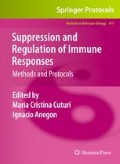Abstract
CD11b+GR1+ myeloid-derived suppressor cells (MDSC) accumulate in several inflammatory conditions including cancer, infections, or trauma. MDSCs are found in bone marrow and lymphoid organs and suppress both innate and adaptive immune responses. Although mechanisms of suppression are not fully understood, they have been reported to require cell–cell contact and very often implicate l-arginine metabolism. We and others recently observed that lipopolysaccharide (LPS) administration, as other TLR ligands, induces MDSC. In this case, MDSC regulate immune response independently of l-arginine metabolism through heme oxygenase-1 activity. Manipulating MDSC as immunoregulators represents an attractive approach for cancer immunotherapy or transplantation. Herein, we describe methods for expanding and purifying MDSC, as well as in vitro and in vivo techniques to measure their suppressive functions.
Access this chapter
Tax calculation will be finalised at checkout
Purchases are for personal use only
References
Strober, S. (1984). Natural suppressor (NS) cells, neonatal tolerance, and total lymphoid irradiation: exploring obscure relationships. Annu. Rev. Immunol. 2: 219–237.
Ostrand-Rosenberg, S., and P. Sinha. (2009). Myeloid-derived suppressor cells: linking inflammation and cancer. J. Immunol. 182: 4499–4506.
Bronte, V., and P. Zanovello. (2005). Regulation of immune responses by L-arginine metabolism. Nat. Rev. Immunol. 5: 641–654.
Zhang, W., S. Liang, J. Wu, and A. Horuzsko. (2008). Human inhibitory receptor immunoglobulin-like transcript 2 amplifies CD11b+Gr1+ myeloid-derived suppressor cells that promote long-term survival of allografts. Transplantation 86: 1125–1134.
Ezernitchi, A. V., I. Vaknin, L. Cohen-Daniel, O. Levy, E. Manaster, A. Halabi, E. Pikarsky, L. Shapira, and M. Baniyash. (2006). TCR zeta down-regulation under chronic inflammation is mediated by myeloid suppressor cells differentially distributed between various lymphatic organs. J. Immunol. 177: 4763–4772.
Almand, B., J. I. Clark, E. Nikitina, J. van Beynen, N. R. English, S. C. Knight, D. P. Carbone, and D. I. Gabrilovich. (2001). Increased production of immature myeloid cells in cancer patients: a mechanism of immunosuppression in cancer. J. Immunol. 166: 678–689.
Gabrilovich, D. I., and S. Nagaraj. (2009). Myeloid-derived suppressor cells as regulators of the immune system. Nat. Rev. Immunol. 9: 162–174.
Mazzoni, A., V. Bronte, A. Visintin, J. H. Spitzer, E. Apolloni, P. Serafini, P. Zanovello, and D. M. Segal. (2002). Myeloid suppressor lines inhibit T cell responses by an NO-dependent mechanism. J. Immunol. 168: 689–695.
Nagaraj, S., K. Gupta, V. Pisarev, L. Kinarsky, S. Sherman, L. Kang, D. L. Herber, J. Schneck, and D. I. Gabrilovich. (2007). Altered recognition of antigen is a mechanism of CD8+ T-cell tolerance in cancer. Nat. Med. 13: 828–835.
De Wilde, V., N. Van Rompaey, M. Hill, J. F. Lebrun, P. Lemaitre, F. Lhomme, C. Kubjak, B. Vokaer, G. Oldenhove, L. M. Charbonnier, M. C. Cuturi, M. Goldman, and A. Le Moine. (2009). Endotoxin-induced myeloid-derived suppressor cells inhibit alloimmune responses via heme oxygenase-1. Am. J. Transplant. 9: 2034–2047.
Ryter, S. W., J. Alam, and A. M. Choi. (2006). Heme oxygenase-1/carbon monoxide: from basic science to therapeutic applications. Physiol Rev. 86: 583–650.
Gasser, D. L., and W. K. Silvers. (1972). Genetics and immunology of sex-linked antigens. Adv. Immunol. 15: 215–247.
Acknowledgment
Nicolas Van Rompaey is Research Fellow of the Fonds Erasme and Alain Le Moine is Research associate of the Fonds National de la Recherche Scientifique FNRS-Belgium.
Author information
Authors and Affiliations
Corresponding author
Editor information
Editors and Affiliations
Rights and permissions
Copyright information
© 2010 Humana Press
About this protocol
Cite this protocol
Van Rompaey, N., Le Moine, A. (2010). Myeloid-Derived Suppressor Cells: Characterization and Expansion in Models of Endotoxemia and Transplantation. In: Cuturi, M., Anegon, I. (eds) Suppression and Regulation of Immune Responses. Methods in Molecular Biology, vol 677. Humana Press, Totowa, NJ. https://doi.org/10.1007/978-1-60761-869-0_12
Download citation
DOI: https://doi.org/10.1007/978-1-60761-869-0_12
Published:
Publisher Name: Humana Press, Totowa, NJ
Print ISBN: 978-1-60761-868-3
Online ISBN: 978-1-60761-869-0
eBook Packages: Springer Protocols

